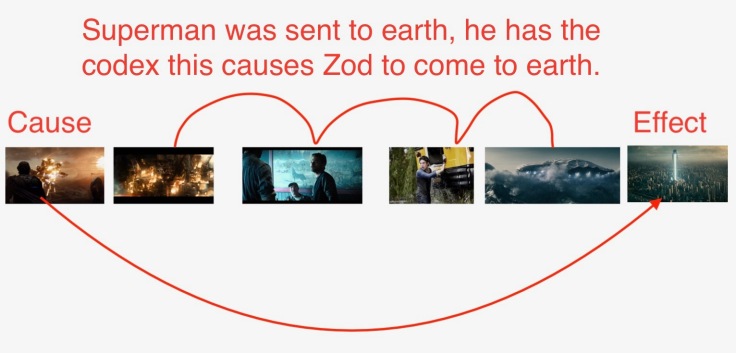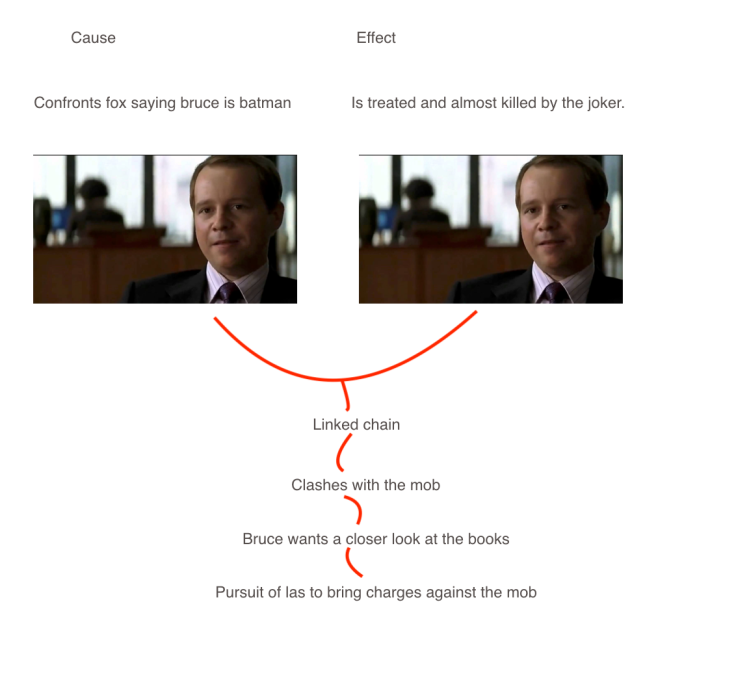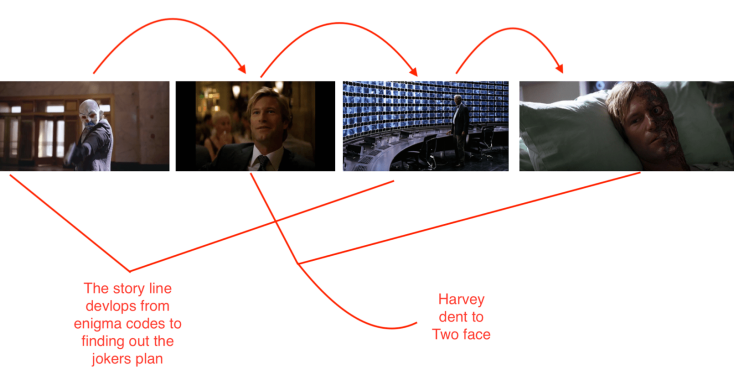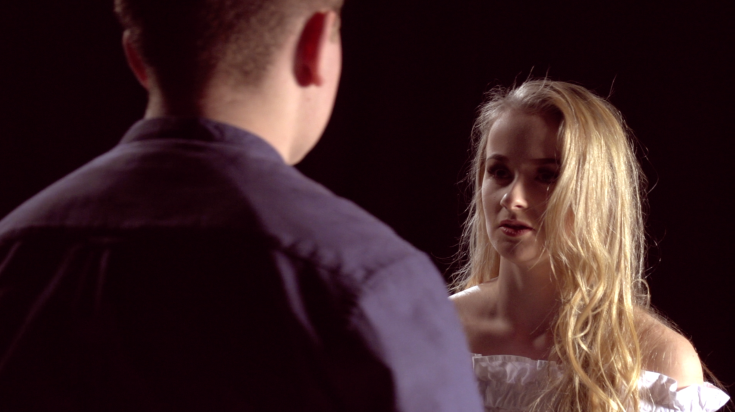Discuss how narratives can be constructed using The Dark Knight (2008) and Man of Steel (2013)?
This essay will discuss how narratives can be constructed using The Dark Knight (2008) and Man of Steel (2013). This essay will do this by following these theorist’s theories: Todorov, Bordwell and Thomson, Levi – Strauss, Vladimir Propp, Ronald Barthes and how they help with narrative construction and character development. By, using The Dark Knight (2008) and Man of Steel (2013) this essay will depict and explain how narrative techniques are used and applied in these films.
Story and plot are the foundations for constructing the narrative. Plot establishes the relationship between the events of a story by using narrative techniques. ‘Implied’ information can be given by dialogue and this might be a ‘crucial narrative point’ about, for example, the childhood of a character (can only be considered part of the ‘plot’ if it is the Introduction in the flashback). Man of Steel’s ‘crucial narrative point’, is the childhood of a character being introduced. In Man of Steel, this would be Superman / Kal’el as a child from Krypton to earth throughout his childhood. In The Dark Knight, this same information can be applied differently compared to Man of Steel as its temporal order (The order of events – can be altered by the plot) is all over the place and being altered by the plot, however, The Dark Knight’s temporal order is shown in a correct and logical order.
The story is all the information, which can be shown and applied in a chronological order of events based on some true or fictitious incidents. The chronological order of events must always start at ‘a’. The Dark Knight and Man of Steel do this, however, the story is altered by the plot. Man of Steel does temporally start at point a then it goes to point c then point b. Narratives can be constructed using temporal order as well as frequency(repeating events, which could repeat the telling of a key event several times throughout a story to either highlight its importance or exhibit its significance in relation to the progression of events.) – In The Dark Knight and Man of Steel temporal frequency is not used as a technique in the films as it isn’t appropriate, although it could be appropriate for creating parallax in a sci-fi time travel genre. And the other temporal duration – (the amount of time passed in a film relative or different. Is one minute, one minute or is it the equivalent of days in the film?) in the films this is used and is important in the films at constructing the narrative. For example, in Man of Steel, there are flashbacks in Man of steel which pass a longer amount of time in less time than it would be in real life which creates a pace in the film. The Dark Knight uses it also to pace the film although it is a little more accurate to real life timing than in Man of Steel.
The plot may also refer to the sequence of events inside a story as ‘causal effect’ which affect other events through the principle of cause and effect. The causal events of a plot can be thought of as a series of sentences using linking verbs such as “and so”. Plots can vary from simple structures such as in a traditional ballad to complex interwoven structures sometimes referred to as an ‘imbroglio’. The term plot can serve as a verb and refer to a character planning future actions in the story. Since most film narratives involve a series of actions, it may seem natural to think that causation is the major connective between scenes in movies. However, it is implausible to suggest that scenes follow each other in most film narratives via a chain of causal ‘entailments’. I would guess that most succeeding narrative scenes are causally underdetermined by what proceeds them. Rather the connection is weaker than a causal one (Narrative Comprehension, 2013 pg. 26). A constellation of set events happens one by one in a storyline. These chains of cause and effect are applied throughout both films to form structures onto the foundations of story and plot to create more in-depth structures. This is done by creating a mixture of ‘causal conflict’. Cause and then the perceived conflict/ effect.

 Linear Narratives present a story in a logical manner by showing the viewer what happens from one point in time to the next without using flashbacks or flash-forwards and then returning to the present. The Dark Knight follows a linear narrative structure. The Dark Knight presents the story as if it has been lived out by the viewer in a logical way. For example, point a to point b to point c. Todorov discussed how linear narratives had to be shown in a linear narrative of an ordered state, however non-linear narratives conflict with Todorov’s theory.
Linear Narratives present a story in a logical manner by showing the viewer what happens from one point in time to the next without using flashbacks or flash-forwards and then returning to the present. The Dark Knight follows a linear narrative structure. The Dark Knight presents the story as if it has been lived out by the viewer in a logical way. For example, point a to point b to point c. Todorov discussed how linear narratives had to be shown in a linear narrative of an ordered state, however non-linear narratives conflict with Todorov’s theory.
Non-Linear Narratives present a story in an illogical manner by showing the viewer what happens in an illogical manner. For example, starting on point c going to point a then to point b. A non-linear/disjointed narrative is a technique sometimes used in films where events are portrayed out of chronological order. Man of Steel appears in an illogical manner.
Narrative stands (different methods of developing storylines) are applied to construct narratives, storylines of characters although each film uses different strands to do this. The Dark Knight uses a multi-strand narrative in which, one or more storylines are developed without flashbacks.

Man of Steel has an asynchronous strand meaning it follows one or more storylines and also has flashbacks. Man of steel starts off in krypton then goes to the present then goes to the childhood of Superman.

Audiences are used to considering narrative as a linear cause and effect chain, these oppositions are less obvious. Berger’s point in identifying these oppositions is to demonstrate that: – One of the ways these oppositions manifest themselves is through the looks of the hero and victim which ties in some of Ronald Barthes narrative codes. Two of the five narrative codes most relevant being Semi codes – the way in which characters, objects, and settings take on particular meanings. For example, Propps, spheres of action are individualised into a character by their codes of speech, clothing, and gesture (although they can be stereotyped.) In The Dark Knight, the Joker plans for chaos and destruction and is ill-dressed and unclean. Whereas the dark knight is Debonair, well dressed and whats both justice and order the opposite of the joker. In the Man of steel the same oppositions are there, however, they are portrayed differently visually general Zod is darkly dressed in a militarian suit of armour whereas Superman is dressed in bright colours as bares a symbol of hope on his chest, as well as this he carries no amour unlike general Zod this shows that he is the hero, a symbol for igniting hope in humanity, a symbol for them not to be destroyed like Krypton. He doesn’t wear armour because he isn’t a general or a soldier has just a man who happens to be krypton and trying to save the earth. Superman doesn’t have agendas like General Zod does. In The Dark Knight, Batman wears black to conceal himself in the darkness, give himself a surprise advantage, concealment, and an escape option. It’s the same reason that ninjas and common robbers dress in dark clothing, therefore, connotation shows that Semantic (Symbolic) codes are crucial as the audience explores the hidden meaning behind certain codes within a film. In Man of steel, Superman wears suit which has colours of red and blue with a symbol on his chest with the connotation of inspiring hope, this follows one of his main purposes as Superman to inspire hope in mankind on earth and help them to become better and stop them, from destroying there own planet like Krypton.
The other of the two codes being Symbiotic – signifies Levi Strauss binary oppositions (such as Good: Evil, Male: Female, Youth: Adult) and or Freudian Symbols. The differences in good vs evil begins to be shown not by the characters visual triads but in their personalities and history. General Zod is killing humanity and attempting to colonize earth, although he is doing it to bring back his people the Kryptonians and from his perspective, he is the hero and Superman is the villain. Whereas Superman is trying to save the earth but is also going against his own people Kryptonians as well as this even though he is saving humans by holding back from killing Zod until the end Superman could be considered responsible for a sizeable amount of the deaths of humans.
The Dark Knight becomes a powerful force much in the same way the joker is. He becomes hunted by Gotham, making people believe that he cannot be controlled. That he has lost all respect for the rule of the law, as Gordan realizes he needs to blame the murders on The Dark Kight, Gordan acknowledges not only the need for society to push their fears onto something but their hopes as well (which he allows them to do by preserving Dent’s good name). Batman is symbolized as the saviour of Gotham city. Superman and Zod are the same in a way they are both from Krypton, were both rejected by the leaders of the planet they called home. Zod was rejected by the council, Superman was surpassed by the military, his planet was willing to turn him into Zod even if it meant him dying.
In The Dark Knight and Man of Steel, the villains are understood as the villains however in these films it’s not so simple as good and bad. From certain perspectives, the villain could be seen as the hero and a character who could be considered both the hero and the villain is General Zod. This creates a binary opposition between the character a conflict which helps to construct and create more layers making the audience think about what really is considered good or bad. Barthes codes are used to construct the narratives. The other three Barthes codes are:
Action codes are significant events used to move the narrative on in a particular direction and change the scenes narrative for a specific reason.
Action codes can be applied in several different scenes in The Dark Knight for example: In the final action scene, the Joker has rigged two ferries carrying people out of Gotham to explode. One ferry carries civilians. The other ferry contains large numbers of prison inmates and some guards. The Joker has rigged both to explode, and he has given the crew on each boat the detonators, only they have the detonator for the other boat. He announces the rules of the game to the crew and passengers of each boat. This makes the audience think what is going to happen next, therefore, the action code is present. In Man of steel, action codes are presented throughout the film from the very start on Krypton when the codex is discovered which later on in the film is of great importance as it is the reason for general did being there with his army to colonize earth for the Kryptonians to be grown. By using this code it makes the audience suspect something is going to happen and its cause is the codex This has the audience sub/ consciously foregoing an action which makes them feel involved in the film.
Hermeneutic or enigma code: all the units whose function it is to articulate in various ways a question, its response, and and the variety of chance events which can either formulate the question or delay its answer; or even constitute an enigma and lead to its solution.
The Joker’s motives are not explained until the end of the film, which leaves the audience wanting more and makes the film more appealing to the audience. We first see The Joker in the opening scene, which leads the audience into questioning ‘Who is he?’ ‘Why is he stealing from the mobs in a bank’. The Jokers plans are not explained until the very end of the film, throughout the movie it is referenced that members of the mob have gone missing and most importantly why the Joker himself is interested in a large sum of money. It leads the audience to the idea he is interested in making a profit from killing the Batman, however, this is not the case when he burns his earnings and reveals how he is simply conducting his actions to display how self-obsessed humans are. In Man of steel, we as the viewers are first shown the planet Krypton which to avid comic fans will recognise as krypton which ties into cultural codes. Although to someone who is watching Superman for the first time not knowing much about him before enigma codes are used to Appeal to the audience having them asking from the start what is this place and what relevance is it to Superman.
Cultural, or referential, codes: these codes refer not to the text’s narrative but to outside the text. The outside, however, is not reality but a common stock of a culture as is expressed in the already written knowledge of morality politics, art, history, psychology, and so on.
The film Batman is a trilogy where the story of each chapter is linked to one another for example after the murder of Harvey Dent Batman was blamed for his death thus he decided to leave Gotham and give up crime fighting and saving the city, where he will return in The Dark Knight Rises. At the beginning of the Man of steel, the audience is brought to krypton the origin of Superman/ Kal-El. Later on, there is a conflict of opinions between Superman’s father and General Zod whom he fights in this scene cultural codes of a form of martial arts is used suggesting a martial arts partially driven culture.
Vladimir Propp came up with an idea of narrative functions rather than the characters individual psychological motivations. According to (Lacey, year) – Morphology of the Folktale. Both Man of Steel and The Dark Knight uses Propps theory to further construct the narrative and create more layers to the narrative by following Propp theory.
Man of steel
1 – Villan – General Zod
2 – The hero – Superman – Centre of the General Zod’s plans
3 – The donor – His farther – Gives suit, Advice helps on General Zod’s ship
4 – The Helper and Dispatcher – Lois Lane – Aids him
5 – The princess – Lois Lane/ Mother – Targeted by General Zod and his army
6 – The false hero – Zod tried to save his planet by killing the council and attempts to bring back his people by attempting to colonize earth. – He thinks he is right in his actions.
7 – The farther – Adoptive parents/Real Parents – Kryptionian – Took in Superman / teaches and leads him.
The Dark Knight
1 – Villan – The Joker – Deformed
2 – The hero – Batman – Centre of Joker’s plans
3 – The donor – Luscious Fox – Gives Batman Utility belt- Bat Mobile and other equipment and advice
4 – The Helper and Dispatcher – Gordan – Aids Batman, Sends Batman after the Joker?
5 – The princess – Rachel Dawes – Targeted by the Joker
6 – The false hero – Harvey Dent/Two-face – Seen as the real hero of Gotham but after Rachel’s death he becomes a villain – Twoface
7 – The farther – Alfred – Took in Batman after the death of his parents – aids him as both Bruce and the batman.
Throughout this discussion, the following will be the main points through the essay: narrative structure, elements and codes. I conclude that the following narrative techniques best construct the narrative in Man of Steel and The Dark Knight. These techniques are temporal duration, order, codes and binary opposition. When I next think about creating a short film or anything that needs a narrative structure the techniques that would be most effective in helping me as a practitioner would be the narrative codes this is because they can create a narrative just on their own as well as create interest in a narrative even one without a defined structure.
Bibliography – Apa Referencing
Narrative comprehension and film
In-text: (Branigan, 2013)
Branigan, E. (2013). Narrative comprehension and film. London [u.a.]: Routledge, p.Page 84 – Story and Plot – Introduction to Film by Nick Lacey.
Introduction to film
In-text: (Lacey, 2016)
Lacey, N. (2016). Introduction to film. London: Palgrave, Macmillan Education, pp.- Introduction to narrative 77. – Todorov and Propp 78. – Story and Plot 84. – Ronald Barthes Narrative Codes 88. – Other Approaches 90. – Post-Modern narratives 39.
Film theory
In-text: (Lapsley and Westlake, 2006)
Lapsley, R. and Westlake, M. (2006). Film theory. 2nd ed. Manchester: Manchester University Press, pp.Chapter 5 page 129 – 155.
Narrative in fiction and film
In-text: (Lothe, 2005)
Lothe, J. (2005). Narrative in fiction and film. Oxford: Oxford Univ. Press, pp. Jakob Lothe – Todorov, Tzvetan 17, 22, 39, 170, 171. – narrative 9, 16 – 17, 227 – Thompson, Kristen 8-9, 12, 30, 44, 70 – Propp, Vladimir 75. – Narrative 3, 4-7, 13-16, 3545, 72-4, 76, 79, 107-8, 119, 158, 164, 167, 187, 211, level, narrative 32-4, 83. – Bordwell, David 8-9, 12, 28-30, 44, 70, 209 – Barthes, Ronald 12, 16, 75-6, 77, 79.


 Linear Narratives present a story in a logical manner by showing the viewer what happens from one point in time to the next without using flashbacks or flash-forwards and then returning to the present. The Dark Knight follows a linear narrative structure. The Dark Knight presents the story as if it has been lived out by the viewer in a logical way. For example, point a to point b to point c. Todorov discussed how linear narratives had to be shown in a linear narrative of an ordered state, however non-linear narratives conflict with Todorov’s theory.
Linear Narratives present a story in a logical manner by showing the viewer what happens from one point in time to the next without using flashbacks or flash-forwards and then returning to the present. The Dark Knight follows a linear narrative structure. The Dark Knight presents the story as if it has been lived out by the viewer in a logical way. For example, point a to point b to point c. Todorov discussed how linear narratives had to be shown in a linear narrative of an ordered state, however non-linear narratives conflict with Todorov’s theory.






















































